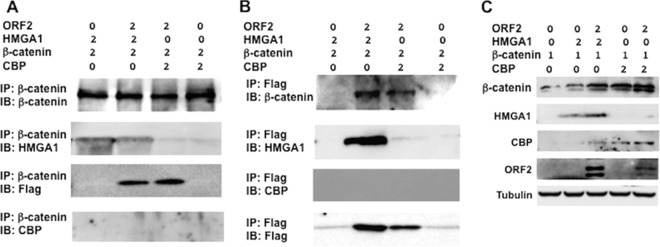FIG 3.
ORF2 is stably associated with HMGA1 and β-catenin. Neuro-2A cells were transfected with the designated plasmids using the indicated DNA concentrations (in micrograms). (A) At 48 h after transfection, IP was performed using total cell lysate (400 μg protein) and a β-catenin-specific antibody (catalog number ab32572; Abcam). Immunoprecipitated proteins bound to magnetic protein A beads (catalog number S1425S; Invitrogen) were washed extensively, suspended in SDS-PAGE buffer, and separated in a 10% SDS-polyacrylamide gel. After the proteins were transferred to a polyvinylidene difluoride membrane, the immunoblot (IB) was probed with the designated antibody: anti-β-catenin antibody (catalog number ab32572; Abcam), anti-HMGA1 antibody (catalog number ab129153; Abcam), anti-Flag monoclonal antibody (catalog number F1804; Sigma), or anti-CBP antibody (catalog number sc-25748; Santa Cruz Biotech). (B) IP was performed using an anti-Flag M2 affinity gel (catalog number A2220; Sigma) to precipitate proteins associated with ORF2. Immunoblotting of the precipitated proteins was performed using the designated antibodies after the beads were washed as described in the Materials and Methods. (C) The levels of the denoted proteins in the total cell lysate (30 μg protein) of transfected Neuro-2A cells were examined at 48 h after transfection using the antibodies described above. The results are representative of those from three independent experiments.

